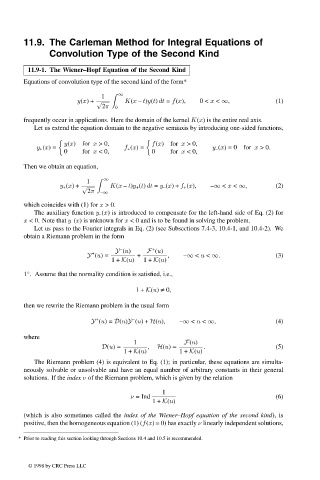Page 568 - Handbook Of Integral Equations
P. 568
11.9. The Carleman Method for Integral Equations of
Convolution Type of the Second Kind
11.9-1. The Wiener–Hopf Equation of the Second Kind
Equations of convolution type of the second kind of the form*
1 ∞
y(x)+ √ K(x – t)y(t) dt = f(x), 0 < x < ∞, (1)
2π 0
frequently occur in applications. Here the domain of the kernel K(x) is the entire real axis.
Let us extend the equation domain to the negative semiaxis by introducing one-sided functions,
y(x) for x >0, f(x) for x >0,
y + (x)= f + (x)= y – (x)=0 for x >0.
0 for x <0, 0 for x <0,
Then we obtain an equation,
∞
1
y + (x)+ √ K(x – t)y + (t) dt = y – (x)+ f + (x), –∞ < x < ∞, (2)
2π –∞
which coincides with (1) for x >0.
The auxiliary function y – (x) is introduced to compensate for the left-hand side of Eq. (2) for
x < 0. Note that y – (x) is unknown for x < 0 and is to be found in solving the problem.
Let us pass to the Fourier integrals in Eq. (2) (see Subsections 7.4-3, 10.4-1, and 10.4-2). We
obtain a Riemann problem in the form
–
+
Y (u) F (u)
+
Y (u)= + , –∞ < u < ∞. (3)
1+ K(u) 1+ K(u)
◦
1 . Assume that the normality condition is satisfied, i.e.,
1+ K(u) ≠ 0,
then we rewrite the Riemann problem in the usual form
–
+
Y (u)= D(u)Y (u)+ H(u), –∞ < u < ∞, (4)
where
1 F(u)
D(u)= , H(u)= . (5)
1+ K(u) 1+ K(u)
The Riemann problem (4) is equivalent to Eq. (1); in particular, these equations are simulta-
neously solvable or unsolvable and have an equal number of arbitrary constants in their general
solutions. If the index ν of the Riemann problem, which is given by the relation
1
ν = Ind (6)
1+ K(u)
(which is also sometimes called the index of the Wiener–Hopf equation of the second kind), is
positive, then the homogeneous equation (1) (f(x) ≡ 0) has exactly ν linearly independent solutions,
* Prior to reading this section looking through Sections 10.4 and 10.5 is recommended.
© 1998 by CRC Press LLC
© 1998 by CRC Press LLC
Page 551

